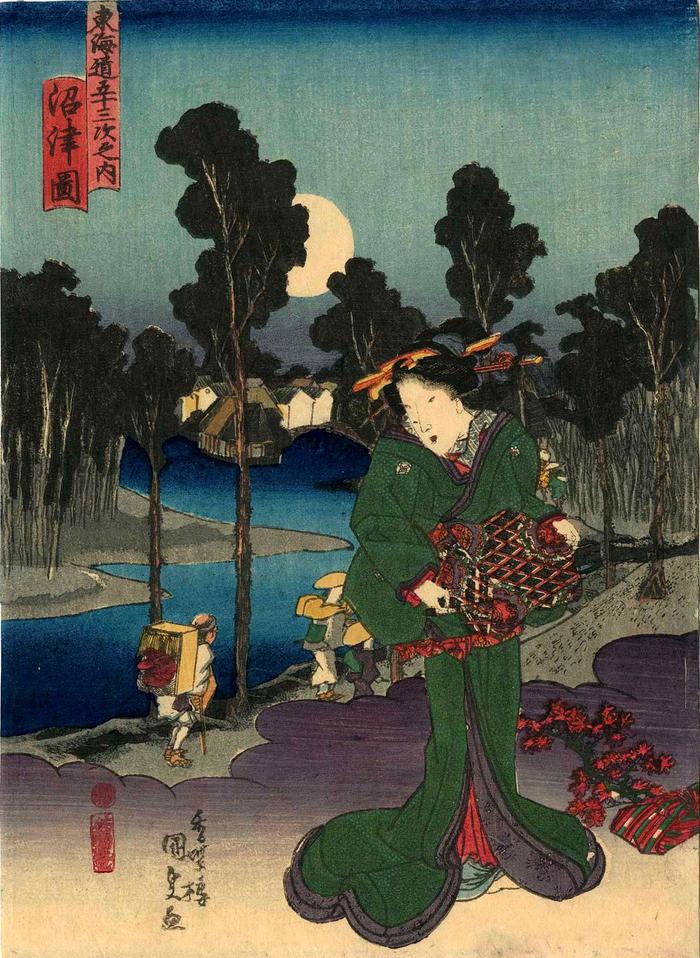Utagawa Kunisada (歌川国貞) / Toyokuni III (三代豊国) (artist 1786 – 01/12/1865)
View of Numazu (Numazu no zu: 沼津図) from the series Fifty-three Stations of the Tōkaidō Road (Tōkaidō gojūsan tsugi no uchi: 東海道五十三次之内)
ca 1838
Signed: Kōchōrō Kunisada (香蝶楼国貞)
Publisher: Sanoya Kihei
Censor's seal: kiwame
Museum of Fine Arts, Boston
National Diet Library
Yale University Art Gallery
Museum für angewandte Kunst, Vienna
British Museum - Hiroshige's 'Numazu tasogare-zu'
Mt. Fuji and Princess Kagiya Museum
Ishikawa Prefectural Museum of Art - they date their copy to 1836
Google maps - the Numazu area
Bryn Mawr
Honolulu Museum of Art
The Spencer Museum of Art
Muzeum Narodowe w Warszawie
Fujisawa Ukiyo-e Museum
Victoria and Albert Museum
Nelson-Atkins Museum of Art All of the prints in this series are chūban sized. The example of this print in the collection of the Museum of Fine Arts in Boston is 10 1/4 x 7 5/16 in. This one in the Lyon Collection is fractionally smaller because it has been trimmed slightly at the top and bottom.
****
This is the thirteenth print in this series. Gian Carlo Calza in his description in Hiroshige: The Master of Nature of the original Hiroshige print re-imagined in this scene said: "A family of pilgrims is walking among rows of Japanese cedars along the Kise River, following the road that leads to Numazu. The mother is holding her son by the hand while the father is transporting a large mask of the Shinto divinity Saruta Hiko. The sun has set and a large full moon, the only one in the series, shines brightly above the trio. They are headed for a Shinto shrine, perhaps on in Konpira on the island of Shikoku, where a procession is held using tengu masks of this size and type. The man is dressed in white to carry the mikoshi, a portable Shinto shrine. The man turns as he walks to admire the forest of the thousand Japanese cedars, one of the area's famous places. They will probably set out again the next day from the port of Numuza."
****
In Tokaido Landscapes: The Path from Hiroshige to Contemporary Artists, 2011, #13, p. 22, speaking of the original Hiroshige print it says in a text by Sasaki Moritoshi: "The evening sun has already set, and a full moon illuminates the scene. On the road along the Kano River, three travelers walk along with their backs to the viewer. The man carrying the mask of a long-nosed tengu goblin is on his way to Shikoku to pray at he Kompira shrine; the mask startles us with a piercing glare that seems directed at the viewer. To the right are a bikuni - a female entertainer who travels the country dressed as a nun - and her apprentice. It is a somewhat desolate scene, but up ahead the buildings of the station town are bathed in moonlight, revealing a place for rest nearby."
****
In Masterworks of Ukiyo-e: Hiroshige, the 53 Stations of the Tōkaidō by Muneshige Narazaki. 1969, p. 42 it says: "It was at Numazu, after the battle of Dan no Ura in the twelfth century, that the twelve-year-old Taira clan heir was captured and was about to be beheaded when his life was spared through the intercession of the priest, Mongaku Shōnin, whose disciple he became until his death fourteen years later."
****
Illustrated:
1) in a small color reproduction in Kunisada's Tokaido: Riddles in Japanese Woodblock Prints by Andreas Marks, Hotei Publishing, 2013, page 62, T24-02.
2) in color in Hiraki Ukiyo-e Library 5: Utagawa Kunisada's Fifty-three Stations of the Tokaido (平木浮世絵文庫5 歌川国貞 東海道五十三次之内), 2011.
Sanoya Kihei (佐野屋喜兵衛) (publisher)
landscape prints (fūkeiga 風景画) (genre)
beautiful woman picture (bijin-ga - 美人画) (genre)
